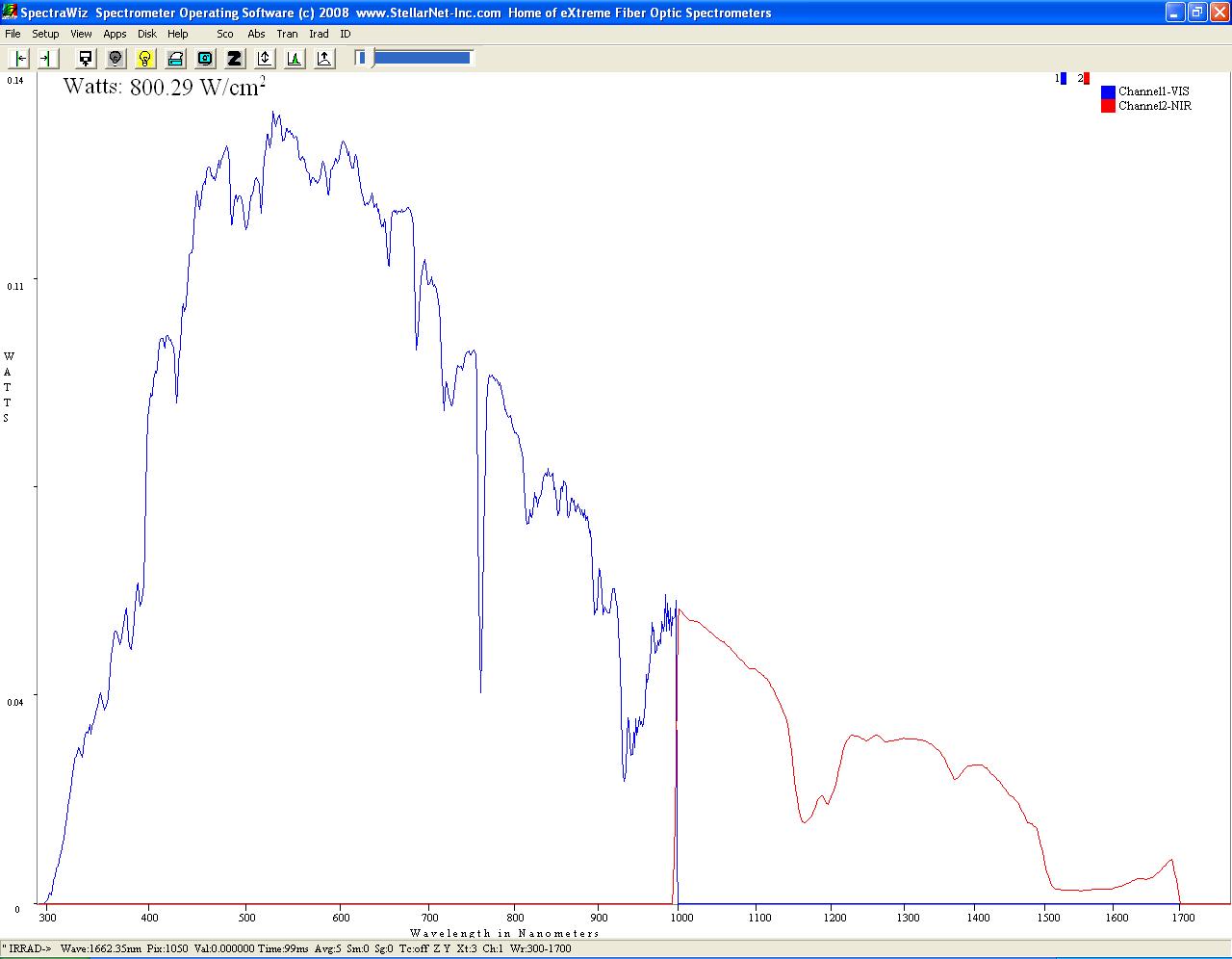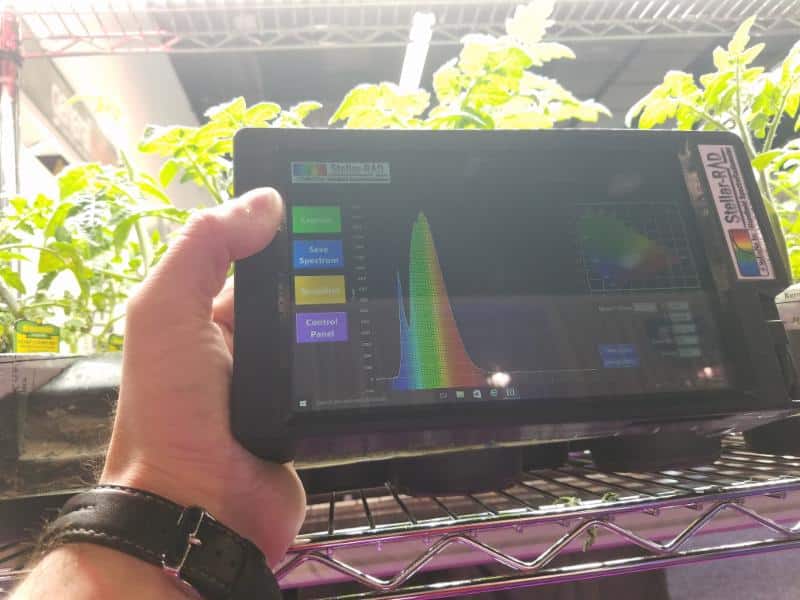It’s Halloween season…Our favorite time of the year and StellarNet’s headquarters just got a little more interesting. A lot of us are wondering how to celebrate Halloween safely during the COVID pandemic. Do we take our kids trick or treating? Do we hand out candy? Bobbing for apples is definitely out of the question. A lot of uncertainty and it can certainly be considered by most: strange and scary times. As if 2020 hasn’t hit us with enough curve balls, something else strange and scary happened at our StellarNet headquarters.
Chapter 1: We Gave her the Best Light –
Using our Spectroradiometers
While walking into the building the other day, Kimberly noticed a strange and mysterious plant by the front door. How did it get here? Where did it come from? Initially, we decided to care for the plant, but we couldn’t seem to identify the species. That gave us free rein in naming it. We decided to call our little plant “Stella 2”.
What happened next is utterly terrifying!
It was time to do a bit more research. The plant looked similar to a Venus flytrap, so we started there. Venus flytraps are carnivorous plants native to subtropical North Carolina and South Carolina wetlands in damp mossy areas. They require at least six hours of direct sunlight daily for photosynthesis. In addition to photosynthesis, Venus flytraps use nitrogen-rich insect proteins to survive. The plant has two nearly circular lobes, with spiny teeth along their margins, which fold together and enclose an insect betwixt. This action is triggered by pressure on sensitive hairs on each lobe. When stimulated by prey, the lobes snap shut in about half a second. Glands on the leaf surface then secrete an enzyme that digests the insect’s body and gives the entire leaf a reddish appearance.
With this in mind, we started by placing a garbage can full of rotting fruit next to Stella 2 to attract the flies and insects. Next, we made sure the soil was moist and placed Stella 2 in an east-facing window where she would get direct sun in the morning hours. We found she wasn’t doing well, so we decided to make use of our radiometers and measure the solar intensity at her window. Was she getting enough sun?
As expected, solar intensity on a clear day had a PAR of 800 W/m^2. PAR represents the photosynthetic active radiation or light emissions within the photosynthetic range between 400-700nm. Considering there seemed to be optimal levels of light reaching her leaves, it was time to go back to the drawing board. We did a little more digging on Venus fly traps…
StellarRAD Handheld Radiometer being used to measure indoor growlights
We found out if grown indoors, Venus flytraps need supplemental lighting. The recommendation is a 40-watt, 3,000K fluorescent light fixture up to 12” above the flytrap turned on 1 hour after sunrise for up to 12-16 hours. Fluorescent lighting tends to emit heat and emit light in all directions, so we considered an LED grow light to be more energy efficient. With this in mind, we introduced a standard grow light that emits at blue (~450nm) and red (~633nm) wavelengths which are the target wavelengths for most plant growth. The ratio of the two wavelengths is a whole science on its own so we just started with the most basic LED grow light.
Since Stella 2 was still receiving sunlight, we placed the LEDs above the plant to supplement the solar light. Light intensity looked optimal but still, she was not doing so well.
What happened next is shocking!
Chapter 2: But She Preferred Blood –
So We used Raman Spectroscopy
Kimberly took her new plant into the laboratory to keep her company while she worked on a customer feasibility study. Immediately, several of the quartz cuvettes accidentally dropped, shattering on the ground, causing quite a commotion.
Kim & David using our Research Raman Spectrometers
David, her lab partner, always eager to help, started to help pick up the fragments of glass. Irresponsibly, David but wasn’t wearing proper safety gear and pricked his gloveless finger. Luckily for him the cuvette did not contain any chemicals or we would have to check the MSDS we require of all customers sending in feasibility studies so that we can investigate and seek proper treatment.
To everyone’s surprise, Stella 2 turned its head towards David’s hand, latched onto his finger, and began to suck the blood out of the wound. Shocked, David pulled back but there was no use – this carnivorous plant was hungry! It turns out that this plant drinks blood! There is no way that Stella 2 is from earth, it must be from out of this world! Now how to find a blood supply….
Light interacts with all matter and we quantify that interaction with our instruments. This makes spectroscopy useful for all sorts of blood analysis. Blood consists mainly of an alkaline liquid (plasma), suspending free floating red blood cells (erythrocytes), white blood cells (leukocytes), and platelets. We can use a standard UV-Vis absorbance setup to analyze the blood, or NIR absorbance, Raman, fluorescence.
David found a demo Raman system in the lab and decided to measure his own blood sample to see if he could find a suitable substitute for human blood for the plant. Only the best for our alien life forms!
Raman spectroscopy is a great technique for measuring unknown samples and identifying these unknowns as long as there are analogous spectra taken previously in a searchable library. Recent studies are increasingly interested in analysis of complex biological samples like blood and tissue, viruses, and other biological samples using Raman. We have many current customers using Raman to develop rapid testing of COVID-19! Wishing them luck 🙂
David used our new handheld Raman spectrometer to capture spectra of his blood and was able to save and recall his own blood sample using the onboard library function. Raman spectroscopy along with advanced chemometrics is often used for hemoglobin, glucose, cholesterol, and protein monitoring.
You won’t believe what happens next!
Chapter 3: Then She Demanded Meat! So We Frantically got the NIR
Now that we figured out Stella 2’s appetite for blood, we thought she was happy. She had grown considerably, so we put her outside near our spectrometer shop’s picnic table. Little did we know what was in store…
Soon after, Stephanie brought her sweet dog Relish to work and needed to conduct a customer feasibility study. It was a beautiful fall day in Tampa and to help socially distance herself, she decided to set up her experiment outside at the picnic table. Relish is a curious pup but as soon as he saw Stella 2 he hid behind Stephanie. Thinking nothing of it, Steph sat down and started getting instrumentation and samples ready to test. Relish began chomping away at his bone happily, forgetting about the very odd plant so close.
Stephanie went inside the StellarNet shop to gather some spectrometers for her experiments and came back to the picnic table and noticed that the ground was wet… “Did Relish spill his water bowl?” she thought as she sat back down. It took a few minutes but she then realized that the picnic table was wet too.
“What is this?!” she asked as she looked around. Then she noticed Stella 2 facing Relish who was blissfully unaware as he ate his bone. She texted Kimberly, David, and Jason asking “Does Stella 2 drool? This is a strange and interesting plant! It wants blood and is drooling?” David quizzed her “What is around that could make it drool?” Could this plant be drooling because of Relish? Or, is it the meaty bone?
Stephanie grabbed the bone away from Relish and pulled off a meaty part and threw it at Stella 2. The plant moved with speed to catch the morsel. Stunned, Stephanie brought Relish inside the spectrometer shop and grabbed the bone and a StellarCASE-NIR to try to figure this out.
The StellarCASE-NIR uses near-infrared reflectance spectroscopy and chemometrics to do composition analysis. By loading a calibration file you can predict moisture, fat, protein, and ash in different meat samples. The calibration was created by using hundreds of different meat samples in varying composition. Stephanie saw that Stella 2 was pretty satisfied with this dried chunk that she pulled off of the bone, but would Stella 2 be interested in actual meat?
She looked through the fridge to see if there were any uncooked burgers leftover from a company cookout. Thankfully, someone neglected cleaning out the refrigerator completely. She took the sample and measured it to see if it was a lean or fatty cut of ground beef. She wanted to test and see if there was a preference between the two. The sample she took from the fridge ended up being about 20% fat. StellarCASE-NIR also has dedicated calibrations to measure Grains, Oilseed, Dairy, Pet Foods, and much more
She took the sample in gloved hands and threw it at the plant. Stella 2 gobbled it up. She texted the team immediately. What else could this plant want? It’s got the best lighting, we gave her blood, and now… meat ??!!
After talking to the team they decided it was best to call in the SpectraWizard to help them out. After all, he harnesses the power of light and helps us gain intelligence through light.
The team gathered and called upon the SpectraWizard. After telling the SpectraWizard what was happening he agreed, “We must banish this alien plant back to its home planet!” The team dragged Stella2 in front of the spectrometer shop and the SpectraWizard swiftly light beamed the plant back to its home planet.
After the dust settled the SpectraWizard turned to Kimberly, David, Stephanie, Jason and the rest of the StellarNet team and told them “If you find any odd plants again, please don’t feed them.”
Happy Halloween from StellarNet!
Hopefully this fun spectroscopy application note will help take your mind off of the pandemic and politics, for just a moment 🙂
It’s true, a portion of our profits from every spectrometer you purchase go directly to our Halloween costume fund! If you have a great idea for next year’s Halloween App note drop us a line at ContactUs@StellarNet.us and see your idea become our next fun App note.



















